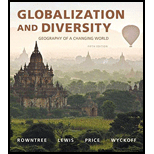
The major ecosystems in Latin America and the way in which humans have adapted to and modified these different ecosystems.
Answer to Problem 4.1R
Latin America has a variety of environmental regions, which include vast upland plateaus, river valleys, mountainous highlands, and low coastal areas. From ancient time onward, the settlements have been observed to be concentrated in the coastal regions and in the interior uplands. At present, the people occupied the riverine environments also for settlement. The highland regions visibly display the anthropogenic adaptation and modification since the agricultural practices are made to adapt to altitudinal zonation.
Explanation of Solution
Much part of Latin America is known for its topicality. Though highlands and deserts prevail throughout the region, the tropical climate and vegetation describe the image of Latin America. The country does not encounter as much environmental damage as that of the East Asia and Europe. Latin America has vast undamaged areas that support unbelievable flora and fauna diversity.
Latin America has varied landforms that encompass vast upland plateaus, high mountains, and extensive river basins. Tectonism could explain the basic topography of the region comprising the geologically young western mountain ranges, such as the Volcanic Axis of Central America and the Andes. There exist many active volcanoes and earthquake-prone regions in Latin America.
The Atlantic side of South America has mostly humid lowlands intermixed with huge upland plateaus known as shields. The great rivers of the world such as the Amazon, Orinoco, and Plata meander through this lowlands.
From earlier times, the settlements were mostly found along the fertile mountain valleys and across the shields of the great rivers. These regions have an arable land, sufficient rainfall, and mild climate because of which these have become the most productive agricultural regions with its densest settlement.
The highlands of Latin America also give a typical character to the area. The regions have a varied ecosystem pertaining to the luxurious tropical valleys found beneath the snow-covered mountains. The most remarkable element of the highlands is the Andes that extends down the South American continent like a spine. The Volcanic Axis of Central America and the Mexican Plateau are the most significant Latin American uplands on account of settlement, since the major cities are located here. However, nowadays, settlements are found in the riverine environments also.
The human modification of the ecosystem and their adaptation to the environment is clearly understood from the highlands. The altitudinal zonation concept is very important for the highlands of Central America, the Mexican Plateau, and the Andes, as it was the concept to which agriculture was adapted, in these regions. For instance, the traditional farmers would use the high pastures of the Altiplano for the llamas and alpacas grazing, the tierra fria to grow quinoa and potatoes, and the lower temperature zone for the production of corn.
Want to see more full solutions like this?
Chapter 4 Solutions
Mastering Geography With Pearson Etext -- Valuepack Access Card -- For Globalization And Diversity: Geography Of A Changing World (5th Edition)
 Applications and Investigations in Earth Science ...Earth ScienceISBN:9780134746241Author:Edward J. Tarbuck, Frederick K. Lutgens, Dennis G. TasaPublisher:PEARSON
Applications and Investigations in Earth Science ...Earth ScienceISBN:9780134746241Author:Edward J. Tarbuck, Frederick K. Lutgens, Dennis G. TasaPublisher:PEARSON Exercises for Weather & Climate (9th Edition)Earth ScienceISBN:9780134041360Author:Greg CarbonePublisher:PEARSON
Exercises for Weather & Climate (9th Edition)Earth ScienceISBN:9780134041360Author:Greg CarbonePublisher:PEARSON Environmental ScienceEarth ScienceISBN:9781260153125Author:William P Cunningham Prof., Mary Ann Cunningham ProfessorPublisher:McGraw-Hill Education
Environmental ScienceEarth ScienceISBN:9781260153125Author:William P Cunningham Prof., Mary Ann Cunningham ProfessorPublisher:McGraw-Hill Education Earth Science (15th Edition)Earth ScienceISBN:9780134543536Author:Edward J. Tarbuck, Frederick K. Lutgens, Dennis G. TasaPublisher:PEARSON
Earth Science (15th Edition)Earth ScienceISBN:9780134543536Author:Edward J. Tarbuck, Frederick K. Lutgens, Dennis G. TasaPublisher:PEARSON Environmental Science (MindTap Course List)Earth ScienceISBN:9781337569613Author:G. Tyler Miller, Scott SpoolmanPublisher:Cengage Learning
Environmental Science (MindTap Course List)Earth ScienceISBN:9781337569613Author:G. Tyler Miller, Scott SpoolmanPublisher:Cengage Learning Physical GeologyEarth ScienceISBN:9781259916823Author:Plummer, Charles C., CARLSON, Diane H., Hammersley, LisaPublisher:Mcgraw-hill Education,
Physical GeologyEarth ScienceISBN:9781259916823Author:Plummer, Charles C., CARLSON, Diane H., Hammersley, LisaPublisher:Mcgraw-hill Education,





